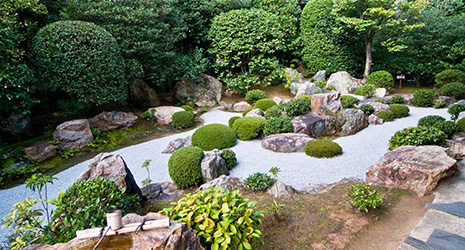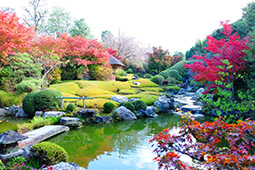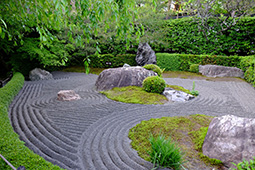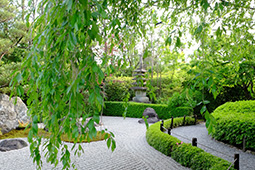INDEX
- English
- 日本語

In the Motonobu no Niwa, white sand is spread out to resemble a pond, at the back of which is an arrangement of rocks representing a waterfall and mountains - English
- 日本語

A stone bridge spans the river of white sand in the Motonobu no Niwa

Japanese garden Yoko-en viewed over the pond in autumn 
The Dark (Yin) Garden of Inyou no Niwa 
The Bright (Yang) Garden of Inyou no Niwa
October 2021
Stones in a Japanese Garden: Permanence and the Changing Seasons

Stones are a key structural element in a Japanese garden. A single stone can be used to balance the appearance of a garden as a whole, or stones can be arranged in combination to represent such things as waterfalls or mountains. One Japanese garden noted for the conspicuous role stones play is Taizo-in, part of the Myoshin-ji temple complex in Kyoto.

Taizo-in is situated in the precincts of Myoshin-ji, a Zen Buddhist temple located in Hanazono, Kyoto City. It has three gardens, each with a different aesthetic appeal: a dry landscape (karesansui) garden, a rock garden, and also a kaiyu-style garden*.
Generally, a dry landscape garden refers to a garden that uses mainly rocks and plants without water to depict mountain and water’s edge landscapes, while a dry landscape garden consisting mainly of rocks and gravel is called a rock garden. Dry landscape gardens have a particularly deep connection to Zen Buddhism**.
“Zen*** was influenced by Taoism in China, and advocates the ideal of ascetic practice in remote mountain locations. The dry landscape garden is a reproduction of that landscape,” explains Matsuyama Daiko, Deputy Head Priest of Taizo-in.

Taizo-in is located in the grounds of Myoshin-ji, a temple complex dating back some 600 years to 1404. It is home to a garden renowned as a dry landscape masterpiece, said to have been created by Kano Motonobu, a painter active from the latter half of the fifteenth century to the early sixteenth century. Motonobu was the second grand patriarch of the Kano school, one of the leading schools of painting of the time, and laid the foundation of the school’s style of painting. The dry landscape garden is called Motonobu no Niwa, and is estimated to have been created when the artist was aged around 70 years old.
In the Motonobu no Niwa, white sand (gravel) is spread to resemble a pond, at the back of which is an arrangement of rocks representing a waterfall that is the source of the water for the pond, and mountains, with a bridge of stones spanning the stream of white sand flowing from the pond. The garden as a whole is said to represent an earthly paradise rather than just a natural landscape. It is famous for its picturesque beauty that only a painter could have created.
The Japanese garden Yoko-en and the rock garden Inyou no Niwa were built in 1965 by Nakane Kinsaku (1917–1995), one of the master landscape garden designers of the twentieth century. The centerpiece of the Yoko-en, a kaiyu-style garden, is a pond filled with actual water, at the back of which is a waterfall represented by rocks used in a similar way as in the Motonobu no Niwa, suggesting a homage to Motonobu. In contrast to Motonobu no Niwa, where evergreen trees are arranged to express the eternal and unchanging character of the garden, the Yoko-en garden is planted with deciduous trees that change with the seasons. This is rare for a Zen temple, and imparts a sense of elegance to its orderly compositional beauty.
Situated near the entrance of Yoko-en is the Inyou no Niwa (Dark and Bright Rock Gardens), a pair of yin and yang rock gardens. The contrast of black sand in the yin garden and white sand in the yang garden expresses the duality of things. Samon (ripple marks) representing the undulations of water are raked into the gravel. Eight rocks in the yin garden and seven in the yang garden are placed in an exquisitely balanced formation, the total number of fifteen having been regarded since ancient times as signifying perfection. The red weeping cherry tree planted in the center of the garden is said to symbolize the fusion of duality.


“Inyou no Niwa is a Japanese garden that incorporates various meanings, such as expressing permanence and the changing seasons, or what is referred to in Zen as ‘funi,’ which represents the oneness of the duality of things. Rocks are an essential element of expression in this. Another aspect of its appeal is the way the colors of the stones change when wet with rain, producing a variety of expressions,” says Matsuyama.
Garden stones are an immovable and unchanging element that communicate the intention of the garden’s creator. However, as Matsuyama says, their color changes even during the course of a single day due to the weather, as well as taking on a different expression over time as they become covered with moss. Japanese people have always placed stones and rocks possessing such duality in their gardens, imbuing them with deep meaning.
* A style of Japanese garden designed to allow the changing landscape to be viewed from various angles.
** Zen Buddhism emphasizes the practice of zazen (sitting meditation).
*** Zen is a school of (Indian) Mahayana Buddhism that originated in China in the sixth century. The practice of Zen spread in Japan from the late 12th century. “Zen” is a Buddhist term meaning “a state in which the mind has become free of agitation.”

